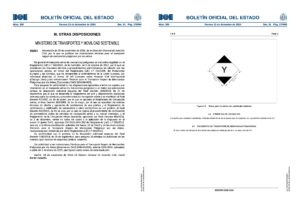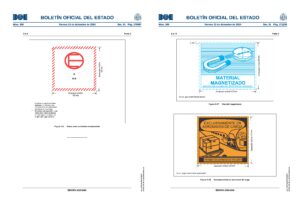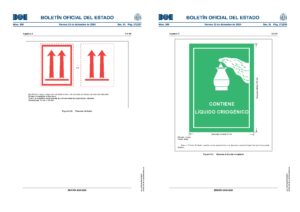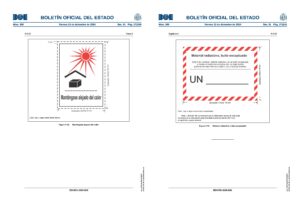The Directorate General of Civil Aviation has published the nineteenth biennial edition of the Technical Instructions, valid from 1 January 2025 to 31 December 2026, to regulate the safe transport of dangerous goods by air, in accordance with Regulation (EU) No 965/2012 and Annex 18 of the Convention on International Civil Aviation (Chicago, 1944). These instructions include amendments harmonized with the UN Model Regulations to improve operational safety and facilitate air transport.
https://www.boe.es/boe/dias/2024/12/13/pdfs/BOE-A-2024-26051.pdf
Main amendments of the 2025-2026 Edition:
General provisions:
Exception for tracking devices with lithium batteries installed.
New definitions such as “filling degree” and clarifications on “exclusive use” and “recycled plastic material”.
Classification and lists of dangerous goods:
Mandatory provision of information to classify dangerous goods upon request of authorities.
Updating of criteria for lithium batteries, Class 1 (Explosives), infectious substances and Class 9 articles.
Inclusion of new headings for substances and articles, such as sodium ion batteries and vehicles powered by various batteries.




Special provisions:
Revision of criteria and additions for specific substances such as gallium, tetramethylammonium hydroxide and fire extinguishing agent dispersion devices.
Inclusion of new provisions (A226-A234) for transition periods and specific classification criteria.
Packaging requirements:
Adjustments in differential pressures for liquids, valve protection and stacking tests.
Revision of specific instructions for lithium, sodium ion batteries and other dangerous articles.
Shipper’s obligations:
Transition periods for identifying vehicles with batteries on transport documents.
New requirements on dimensions and documentation for radioactive material.
Operational requirements:
Protection and safe transport of devices with lithium batteries in the cabin to avoid damage and accidental activation.
This edition seeks to ensure safety, clarity and technical updating for air operators and shippers in the handling of dangerous goods.Resolution on the Technical Instructions for the Safe Transport of Dangerous Goods by Air (Edition 2025-2026)
The Directorate General of Civil Aviation has published the nineteenth biennial edition of the Technical Instructions, valid from January 1, 2025 to December 31, 2026, to regulate the safe transport of dangerous goods by air, in accordance with Regulation (EU) No. 965/2012 and Annex 18 of the Convention on International Civil Aviation (Chicago, 1944). These instructions include amendments harmonized with the UN Model Regulations to improve operational safety and facilitate air transport.
Main amendments of the 2025-2026 Edition:
General provisions:
Exception for tracking devices with lithium batteries installed.
New definitions such as “filling degree” and clarifications on “exclusive use” and “recycled plastic material”.
Classification and lists of dangerous goods:
Mandatory provision of information to classify dangerous goods upon request of authorities.
Update of criteria for lithium batteries, Class 1 (Explosives), infectious substances and Class 9 articles.
Inclusion of new headings for substances and articles, such as sodium ion batteries and vehicles powered by various batteries.
Special provisions:
Revision of criteria and additions for specific substances such as gallium, tetramethylammonium hydroxide and fire extinguishing agent dispersion devices.
Inclusion of new provisions (A226-A234) for transition periods and specific classification criteria.
Packaging requirements:
Adjustments to differential pressures for liquids, valve protection and stacking tests.
Revision of specific instructions for lithium, sodium ion batteries and other dangerous goods.
Shipper obligations:
Transition periods to identify vehicles with batteries in transport documents.
New requirements on dimensions and documentation for radioactive material.
Operational requirements:
Protection and safe transport of devices with lithium batteries in the cabin to avoid damage and accidental activation.
This edition seeks to ensure safety, clarity and technical updating for air operators and shippers in the handling of dangerous goods.
The amendments in EDITION 2025-2026 cover in more detail the following:
– revisions to the general provisions, including the following:
– addition of a new exception for data loggers and cargo tracking devices with lithium batteries installed that are attached to or packed in packages, overpacks or unit load compartments (1;1.1.5.1 i));
– addition of a new definition of “degree of filling” (1;3);
– addition of a note under the definition of “exclusive use” for clarity (1;3); and
– clarification of the definition of “recycled plastic material” (1;3);
– revision of the classification criteria, including the following:
– addition of a requirement for the shipper to make available to the competent national authority on request the information that it has used to classify dangerous goods (2; introductory chapter, 1.2);
– clarification of the classification criteria for articles containing dangerous goods not otherwise specified, when they contain lithium cells or batteries (2; introductory chapter, 6.0);
– revision of the definitions that apply to Class 1 – Explosives (2;1.2);
– addition of new headings to the list of organic peroxides currently assigned on packaging (Table 2-7);
– updating of the indicative examples of infectious substances included in Category A with respect to Mpox virus (simian virus) (Table 2-10); and
– revision of the list of substances and articles in Class 9 (Table 2-16), including:
– the addition of new headings for sodium-ion batteries and vehicles powered by lithium-ion and sodium-ion batteries; and
– the addition of criteria for exempting from the Technical Instructions pharmaceutical products containing genetically modified microorganisms (GMMOs) or genetically modified organisms (GMOs);
– addition of classification criteria for sodium-ion batteries (2;9.4)
– addition of new headings in Table 3-1, including:
– Disilane (UN 3553);
– Dispersing devices for extinguishing agents (UN 0514);
– Dispersing devices for extinguishing agents (UN 3559);
– Gallium contained in manufactured articles (UN 3554);
– Sodium-ion batteries with organic electrolyte (UN 3551);
– Sodium-ion batteries installed in equipment with organic electrolyte (UN 3552);
– Sodium-ion batteries packed with equipment with organic electrolyte (UN 3552);
– Tetramethylammonium hydroxide in aqueous solution containing at least 25 % tetramethylammonium hydroxide (UN 3560);
– Tetramethylammonium hydroxide in aqueous solution with not more than 2.5 % tetramethylammonium hydroxide (UN 1835);
– Trifluoromethyltetrazole sodium salt in acetone with not more than 68 % acetone by mass (UN 3555);
– Lithium-ion battery-powered vehicle (UN 3556);
– Lithium metal battery-powered vehicle (UN 3557); and
– Sodium ion battery-powered vehicle (UN 3558);
– renaming of headings in Table 3-1, including:
– from batteries containing sodium to batteries containing sodium metal or sodium alloy in UN 3292;
– from cells containing sodium to cells containing sodium metal or sodium alloy in UN 3292; and
– tetramethylammonium hydroxide in solution to tetramethylammonium hydroxide in aqueous solution with more than 2.5 % but less than 25 % tetramethylammonium hydroxide (UN 1835);
– assignment of Special Provision A88 to:
– Articles containing corrosive substances, n.o.s.* (UN 3547);
– Articles containing flammable gases, n.o.s.* (UN 3537);
– Articles containing flammable liquids, n.o.s.* (UN 3540);
– Articles containing flammable solids, n.o.s.* (UN 3541);
– Articles containing miscellaneous dangerous goods, n.o.s.* (UN 3548); and
– Articles containing toxic substances, n.o.s.* (UN 3546);
– revision of the special provisions, including:
– Special Provision A40: clarification of the criteria for classifying an explosive as phlegmatized;
– Special Provision A69: updated with the addition of gallium;
– Special Provisions A88, A99, A146 and A154: updated with the addition of sodium ion cells or batteries;
– Special Provision A107: revised to allow machines, apparatus or devices to contain larger quantities of environmentally hazardous substances and to exempt from the Instructions those containing smaller quantities;
– Special Provision A115: updated with the addition of extinguishing agent dispersion devices;
– Special Provisions A123 and A199: provisions are added allowing the transport in the active state of devices powered by dry batteries or nickel-metal hydride batteries;
– Special Provision A129: added criteria to allow the carriage of hot concentrated solutions of ammonium nitrate;
– Special Provision A164: deleted due to redundancy;
– Special Provisions A185 and A214: revised with the addition of new headings in Table 3-1 for Lithium-ion battery-powered vehicle (UN 3556); Lithium metal battery-powered vehicle (UN 3557); and Sodium-ion battery-powered vehicle (UN 3558); and
– Special Provision A190: clarification of the provision for the carriage of neutron radiation detectors containing non-pressurized boron trifluoride gas;
– addition of the following new special provisions:
– Special Provision A226: a transitional period is added during which the UN numbers assigned to electric detonators (UN 0030, 0255 and 0456) may be used instead of the UN numbers assigned to electronic detonators (UN 0511, 0512 and 0513);
– Special Provision A228: classification criteria for sodium-ion cells and batteries with organic electrolyte, as distinct from sodium-ion batteries with aqueous alkaline electrolyte;
– Special Provision A229: classification criteria for UN 1010 – Stabilized butadiene or stabilized mixture of butadiene and hydrocarbons;
– Special Provision A230: criteria for exempting UN 3270 – Nitrocellulose membrane filters from the Technical Instructions;
– Special provision A231: criteria for exempting vehicles powered by sodium ion batteries from the Technical Instructions;
– Special provision A232: criteria for classification of fire extinguishing agent dispersion devices;
– Special provision A233: criteria for classification of tetramethylammonium hydroxide in aqueous solution; and
– Special provision A234: transition period prior to mandatory use of new provisions in Table 3-1 for tetramethylammonium hydroxide in aqueous solution;
– revision of general conditions relating to packagings and the Packaging Instructions:
– new provision extending the permit for a lower internal differential pressure for liquids in Packing Group III of Class 3 or Division 6.1 to those in Class 9 (4;1.1.6);
– revision of protection requirements for cylinder valves and cryogenic receptacles containing Class 2 gases (4;4.1.1.8);
– revision of Packing Instruction 650, including:
– clarification of the test criteria;
– possibility of providing certain information required for infectious substances assigned to UN number 3373 in machine-readable format;
– revision of Packing Instruction 952, including:
– the addition of new UN numbers for vehicles powered by lithium-ion and sodium-ion batteries;
– the addition of provisions for vehicles powered by lithium-ion batteries, rechargeable lithium metal batteries and sodium-ion batteries to be transported with a state of charge in the batteries not exceeding 30 % of their nominal capacity or an indicated capacity not exceeding 25 %;
– revision of Packing Instruction 955 with the addition of sodium-ion batteries;
– revision of Packing Instruction 961 with the addition of UN 3559 – Fire extinguishing agent dispersion devices;
– revision of Packing Instruction 964 to clarify that the differential pressure requirements for packages containing UN 3082 – Environmentally hazardous substance, liquid, n.o.s. are only exempted when packed in combination packagings;
– revision of the packing instructions for lithium batteries, including:
– the requirement applying to UN 3480 – Lithium-ion batteries to be transported in a state of charge not exceeding 30% of their nominal capacity is extended to UN 3481 – Lithium-ion batteries installed in equipment and UN 3481 – Lithium-ion batteries packed with equipment (Packing Instructions 966 and 967);
– addition of a requirement for packagings not subject to Part 6 suitability testing to pass a stacking test (section II of packing instructions 966 and 969 and sections I and II of packing instructions 967 and 970);
– addition of packing instructions for sodium-ion batteries (packing instructions 976, 977 and 978);
– revision of shipper obligations, including:
– addition of provisions for sodium-ion batteries (5:2 and 5:3);
– addition of a three-month transitional period during which lithium battery-powered vehicles may be identified on the dangerous goods transport document as UN 3171 – Battery-powered vehicle instead of UN 3556 – Lithium-ion battery-powered vehicle, UN 3557 – Lithium metal battery-powered vehicle or UN 3558 –
